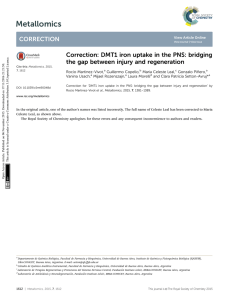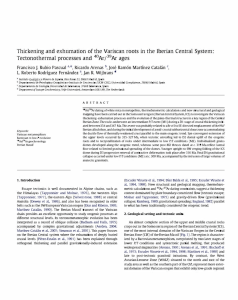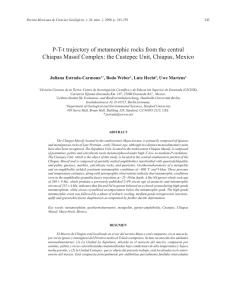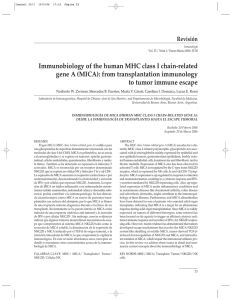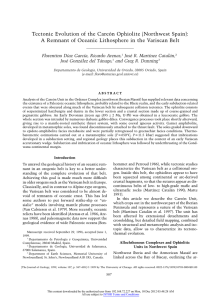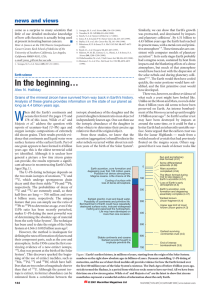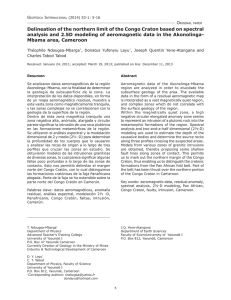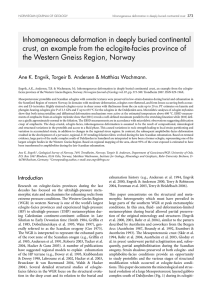Pressure-Temperature-time paths from the Limón Verde
Anuncio
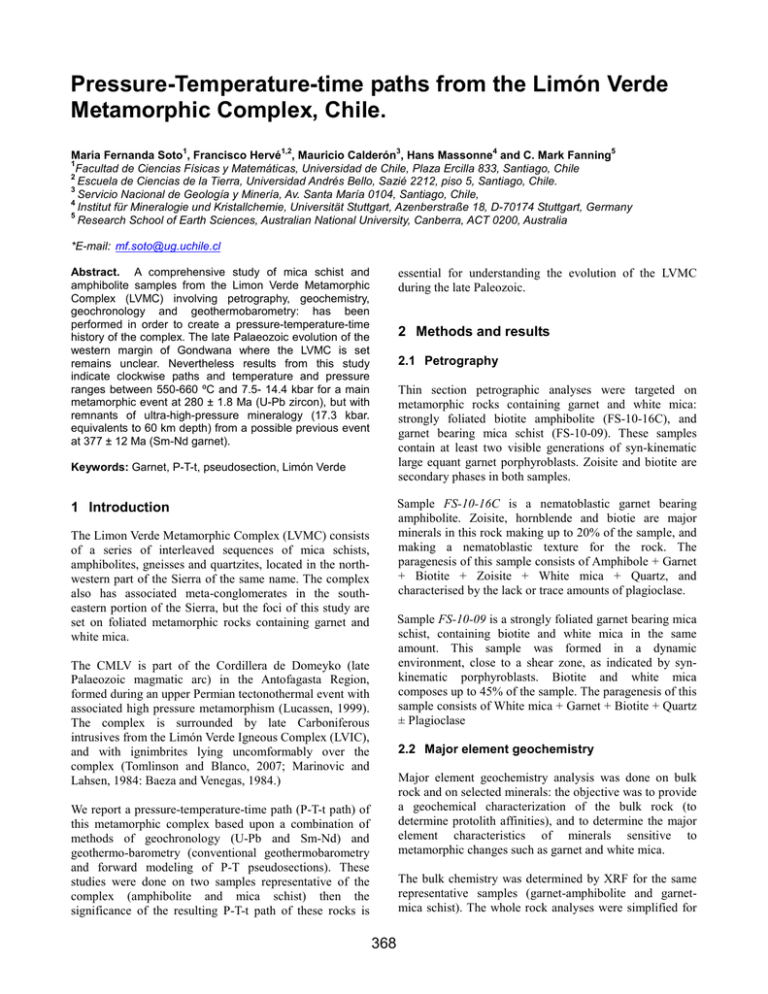
Pressure-Temperature-time paths from the Limón Verde Metamorphic Complex, Chile. 1 1,2 3 4 5 María Fernanda Soto , Francisco Hervé , Mauricio Calderón , Hans Massonne and C. Mark Fanning Facultad de Ciencias Físicas y Matemáticas, Universidad de Chile, Plaza Ercilla 833, Santiago, Chile 2 Escuela de Ciencias de la Tierra, Universidad Andrés Bello, Sazié 2212, piso 5, Santiago, Chile. 3 Servicio Nacional de Geología y Minería, Av. Santa María 0104, Santiago, Chile, 4 Institut für Mineralogie und Kristallchemie, Universität Stuttgart, Azenberstraße 18, D-70174 Stuttgart, Germany 5 Research School of Earth Sciences, Australian National University, Canberra, ACT 0200, Australia 1 *E-mail: [email protected] Abstract. A comprehensive study of mica schist and amphibolite samples from the Limon Verde Metamorphic Complex (LVMC) involving petrography, geochemistry, geochronology and geothermobarometry: has been performed in order to create a pressure-temperature-time history of the complex. The late Palaeozoic evolution of the western margin of Gondwana where the LVMC is set remains unclear. Nevertheless results from this study indicate clockwise paths and temperature and pressure ranges between 550-660 ºC and 7.5- 14.4 kbar for a main metamorphic event at 280 ± 1.8 Ma (U-Pb zircon), but with remnants of ultra-high-pressure mineralogy (17.3 kbar. equivalents to 60 km depth) from a possible previous event at 377 ± 12 Ma (Sm-Nd garnet). essential for understanding the evolution of the LVMC during the late Paleozoic. 2 Methods and results 2.1 Petrography Thin section petrographic analyses were targeted on metamorphic rocks containing garnet and white mica: strongly foliated biotite amphibolite (FS-10-16C), and garnet bearing mica schist (FS-10-09). These samples contain at least two visible generations of syn-kinematic large equant garnet porphyroblasts. Zoisite and biotite are secondary phases in both samples. Keywords: Garnet, P-T-t, pseudosection, Limón Verde Sample FS-10-16C is a nematoblastic garnet bearing amphibolite. Zoisite, hornblende and biotie are major minerals in this rock making up to 20% of the sample, and making a nematoblastic texture for the rock. The paragenesis of this sample consists of Amphibole + Garnet + Biotite + Zoisite + White mica + Quartz, and characterised by the lack or trace amounts of plagioclase. 1 Introduction The Limon Verde Metamorphic Complex (LVMC) consists of a series of interleaved sequences of mica schists, amphibolites, gneisses and quartzites, located in the northwestern part of the Sierra of the same name. The complex also has associated meta-conglomerates in the southeastern portion of the Sierra, but the foci of this study are set on foliated metamorphic rocks containing garnet and white mica. Sample FS-10-09 is a strongly foliated garnet bearing mica schist, containing biotite and white mica in the same amount. This sample was formed in a dynamic environment, close to a shear zone, as indicated by synkinematic porphyroblasts. Biotite and white mica composes up to 45% of the sample. The paragenesis of this sample consists of White mica + Garnet + Biotite + Quartz ± Plagioclase The CMLV is part of the Cordillera de Domeyko (late Palaeozoic magmatic arc) in the Antofagasta Region, formed during an upper Permian tectonothermal event with associated high pressure metamorphism (Lucassen, 1999). The complex is surrounded by late Carboniferous intrusives from the Limón Verde Igneous Complex (LVIC), and with ignimbrites lying uncomformably over the complex (Tomlinson and Blanco, 2007; Marinovic and Lahsen, 1984: Baeza and Venegas, 1984.) 2.2 Major element geochemistry Major element geochemistry analysis was done on bulk rock and on selected minerals: the objective was to provide a geochemical characterization of the bulk rock (to determine protolith affinities), and to determine the major element characteristics of minerals sensitive to metamorphic changes such as garnet and white mica. We report a pressure-temperature-time path (P-T-t path) of this metamorphic complex based upon a combination of methods of geochronology (U-Pb and Sm-Nd) and geothermo-barometry (conventional geothermobarometry and forward modeling of P-T pseudosections). These studies were done on two samples representative of the complex (amphibolite and mica schist) then the significance of the resulting P-T-t path of these rocks is The bulk chemistry was determined by XRF for the same representative samples (garnet-amphibolite and garnetmica schist). The whole rock analyses were simplified for 368 Arizona along with powdered whole rock. Core and rim were sampled using a micromill, and analysed with TIMS along with the powdered whole rock. These analyses gave a Sm-Nd isochron age of 380±21 for sample FS-10-16C and 375± 13 Ma for sample FS-10-09. Core and rim Sm/Nd ratios are very similar indicating homogeneity in these elements in the crystals. Although in both samples the ages are very concordant with each other, these differ to what has been previously obtained with a similar technique, around 270 Ma (Lucassen, et al 1999). the thermodynamic calculations of P-T pseudosections using the PerpleX programs (Connolly, 1990), available for download at http://www.perplex.ethz.ch/. Mineral chemistry was determined with a SX-100 Cameca Electron Microprobe Analyser (EMPA) and then recalculated to get mineral structural formulae with CALCMIN (Brandelik, 2009). Structural formulae for garnets from the garnet bearing amphibolite and garnet mica schist (mentioned earlier), were recalculated to 12 oxygens per formula unit. The garnets from both samples have a prominent almandine component; garnets from mica schist sample show a coreto-rim enrichment in their pyrope component and a coreto-rim depletion in their grossular one. On the contrary, the garnet from amphibolite samples has a grossular component with almost the same pattern as pyrope, indicating a prograde enrichment in both elements (Ca and Mg). 2.4 Pressure-temperature determinations Previous studies in the area have given temperature ranges of 660ºC-720ºC and pressure estimates of 13 ± 1 kbar (Lucassen, et al 1999). The chemical composition of minerals from studied samples were used in a combination of the garnet-biotite thermometer and the garnet-Al2SiO5quartz-plagioclase barometer (Ferry and Spear, 1978; Ghent, 1976) to obtain the following temperature ranges: 525-610ºC for the garnet schist and 370-525ºC for the garnet amphibolite, and pressures of 7.5-12.5 in the schist and 5.6-9.4 in the amphibolite. These intercepts were measured from core-to-rim analyses and in both cases, a prograde path is visible. White mica is present in both samples: the two samples analysed with microprobe contained large laths of white mica parallel to the main foliation. Structural formulae were determined along with the number of Si atoms per formula unit, by recalculating the elemental analyses to a double formula unit on the basis of 42 valences (Brandelik, 2009). The minimum value for the number of Si is barely the same for the amphibolite and the mica schist samples: 3.12, but the maximum for mica schist was in the range of 3.17 as opposed to the larger value 3.23 for white micas in amphibolites. 2.3 Zircon U-Pb geochronology and garnet The bulk chemistry of the above mentioned samples plus a third one, FS-10-16A (a zoisite schist), bear garnet and white mica in different amounts. These bulk chemistry analyses were considered to create the P-T pseudosections. Although these samples had a different whole rock composition, the pseudosections were calculated on the NCKFMASHTO system. Similarly, the garnet components and Si content of white micas were input in these scripts to plot isopleths. Matching the modelled and measured compositions of minerals contoured by the isopleths provide thermobarometric contraints. Taking into account the parageneses of the samples and the isopleth intercepts, we were able to construct pressure-temperature fields: 576660ºC and 7.5-11.5 kbar for sample FS-10-09. Sample FS10-16C had a field of 503-603ºC a lower pressure bound of 8.1 kbar, but white mica isopleths indicate a minimum pressure of 17.3 kbar. P-T ranges are indicated as boxes in Figure 1. Sm-Nd Zircon and garnet are minerals that grow under medium grade to upper metamorphic conditions, with the characteristic that their growth leaves marks a zoning pattern in the crystal structure: each of these patterns constraints the temperatures of metamorphic events. SHRIMP U-Pb zircon ages were obtained from two mica schist samples (FO-09-08 and FO-09-13) collected during a 2009 field campaign: although the sampling location is not the same, it is within 300m of distance from where the rest of the samples were taken. Mineral separation was done at Universidad de Chile and zircon analysis at the Australian National University. In sample FO-09-08: 41 grains and 47 spots were analysed, mostly from the borders of the grains, and in sample FO-09-13: 50 grains were analysed. Rim analyses from zoned zircons with Th/U ratios smaller than 0.1 were considered as true metamorphic (65 spots; cf. Hoskin and Schaltegger, 2007) and show a normal distribution between 260 and 300 Ma with a peak age of metamorphism at 280 ± 1.8 Ma 3 Discussion and conclusions 3.1 Discussion of results Geothermo-barometry considering core-to-rim analyses in garnet indicate a clockwise path for prograde metamorphism, shown in Figure 1. PerpleX calculations yield temperature ranges between 550ºC and 660ºC, and pressure between 7.5-14.4 kbar for the main metamorphic event which is presumed to have formed the parageneses these samples. This event is correlated with a metamorphic peak of 280 ± 1.8 Ma based on U-Pb zircon ages as seen in Garnets examined for Sm-Nd isochron analyses belong to the samples mentioned in earlier (FS-10-16C and FS-1009). These were handpicked and sent to University of 369 results have neither been incorporated into a tectonodynamic model involving regional geology. The correlation with existing data of the area and the development of a model is part of the future work, and the culmination of this research. Figure 1. On the other hand, the Sm-Nd results from this work indicate an average age of metamorphism of 377±12 Ma between both samples. Although there is a strong major element zoning in garnets from both studied samples core and rim Sm/Nd ratios are similar thus indicating homogenization of minor elements. Because chemical homogenization occurs at temperatures of ca. 650ºC (Ducea, et al 2003), whithin the temperature range calculated for the examined rocks, the Sm-Nd ages may represent “mixing” age what needs further interpretation of its geological meaning. Acknowledgements FONDECYT project # 1095099 (F.H.) and the BMBFCONICYT collaboration program 175-2009 (F.H. and H.J.M.) funded this project. Thanks also to Thomas Theye for instructing with microprobe analysis techniques in Stuttgart. The authors would also like to thank Antofagasta Minerals S.A. for providing lodge and logistics of the field campaigns. Finally, the garnet-amphibolite sample (FS-10-16C) has remnant mineralogy that indicates that this rock was once subjected to pressures over 17.3 kbar (equivalent to at least 60km depth). References Baeza, L.; Venegas, R. 1984. El basamento cristalino de la Sierra Limón Verde, IIª región de Antofagasta: Consideraciones genéticas. Revista Geológica de Chile, 22: 25-34. Brandelik, A.; 2009. CALCMIN - an EXCEL™ Visual Basic application for calculating mineral structural formulae from electron microprobe analyses. Computers and Geosciences 35: 1540-1551 Connolly, J.A.D. 1990. Multivariable phase diagrams, an algorithm based on generalized thermodynamics. American Journal of Science 290 (6): 666-718. Ducea, M.N.; Ganguly, J.; Rosenberg, E.; Patchett, P.J.; Cheng, W.; Isachsen, C. 2003. Sm-Nd dating of spacially controlled domains of garnet single crystals: a new method of high temperature thermochronology. Earth and Planetary Science Letters. 213: 3142 Ferry, J.M.; Spear, F.S.; 1978. Experimental calibration of the partitioning of Fe and Mg between biotite and garnet. Contributions to Mineralogy and Petrology. 66: 113-117 Ghent, E.D. 1976. Plagioclase-garnet- Al2SiO5 -quartz : a potential geobarometer-geothermometer. American Mineralogist. 61:710714. Figure 1. Tentative pressure-temperature-time path for samples FS-10-16C (garnet amphibolite), FS-10-16A (zoisite schist) and FS-10-09 (garnet mica schist). Data was obtained through modelling of PT pseudosection with PerpleX and correlated with classic geothermobarometry calculations. Boxes PerpleX 1 and 2 correspond to the fields determined by white mica isopleth intersection, and the paragenesis seen in sample FS-10-16C. Hoskin, P.W.O.; Schaltegger, U. 2003. The composition of Zircon and Igneous and Metamorphic Petrogenesis. In Zircon. Reviews in Mineralogy and Geochemistry (Hanchar, J.M. and Hoskin, P. W.O.; editors). 53:27-62 Lucassen, F.; Franz, G.; Laber, A. 1999. Permian high pressure rocksthe basement of the Sierra de Limon Verde in Northern Chile. Journal of South American Sciences 12: 183-199. 1999 3.2 Preliminary conclusions and future work Marinovic, N.; Lahsen, A.. 1984. Hoja Calama, Región de Antofagasta. Servicio Nacional de Geología y Minería. Publicación No. 58. A prograde P-T-t path during the late Paleozoic is deduced from this work. However, the two distinct metamorphic ages obtained, one from zircon and the other from garnet Nd-Sm isochrons, seem to be contradictory, as detrital zircons of intermediate age are also observed in the mica schist. An interpretation of these data is needed. These Tomlinson, A.J.; Blanco, N. 2007. Geología de la franja El AbraChuquicamata, II región (21º45’-22º30’). Informe registrado IR07##. Servicio Nacional de Geología y Minería. Corporación Nacional del Cobre. 370
